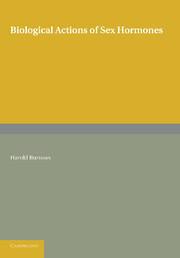Book contents
- Frontmatter
- CONTENTS
- PREFACE
- PART I GONADOTROPHINS
- PART II GONADAL HORMONES
- PART III ANDROGENS
- PART IV OESTROGENS
- CHAPTER XI Oestrogens
- CHAPTER XII The Action of Oestrogen on the Embryonic Gonads. and Miillerian and Wolffian Systems
- CHAPTER XIII The Action of Oestrogen on the Anterior Lobe of the Pituitary, and on the Gonads after their Differentiation
- CHAPTER XIV The Action of Oestrogen on the Accessory Genital Organs after their Differentiation, with a special reference to inguinal hernia
- CHAPTER XV The Action of Oestrogen on the Accessory Genital Organs
- CHAPTER XVI The Action of Oestrogen on the Accessory Genital Organs
- CHAPTER XVII The Effects of Oestrogen on the Mamma
- CHAPTER XVIII Factors in the Causation of Mammary Cancer
- CHAPTER XIX The Effects of Oestrogen on Connective Tissues and Skin
- CHAPTER XX The Actions of Oestrogen on organs other than those considered in earlier chapters
- PART V PROGESTINS
- PART VI SEX HORMONES OF THE ADRENAL CORTEX
- APPENDIX
- REFERENCES
- GLOSSARY
- INDEX
CHAPTER XII - The Action of Oestrogen on the Embryonic Gonads. and Miillerian and Wolffian Systems
from PART IV - OESTROGENS
Published online by Cambridge University Press: 05 June 2016
- Frontmatter
- CONTENTS
- PREFACE
- PART I GONADOTROPHINS
- PART II GONADAL HORMONES
- PART III ANDROGENS
- PART IV OESTROGENS
- CHAPTER XI Oestrogens
- CHAPTER XII The Action of Oestrogen on the Embryonic Gonads. and Miillerian and Wolffian Systems
- CHAPTER XIII The Action of Oestrogen on the Anterior Lobe of the Pituitary, and on the Gonads after their Differentiation
- CHAPTER XIV The Action of Oestrogen on the Accessory Genital Organs after their Differentiation, with a special reference to inguinal hernia
- CHAPTER XV The Action of Oestrogen on the Accessory Genital Organs
- CHAPTER XVI The Action of Oestrogen on the Accessory Genital Organs
- CHAPTER XVII The Effects of Oestrogen on the Mamma
- CHAPTER XVIII Factors in the Causation of Mammary Cancer
- CHAPTER XIX The Effects of Oestrogen on Connective Tissues and Skin
- CHAPTER XX The Actions of Oestrogen on organs other than those considered in earlier chapters
- PART V PROGESTINS
- PART VI SEX HORMONES OF THE ADRENAL CORTEX
- APPENDIX
- REFERENCES
- GLOSSARY
- INDEX
Summary
Embryonic gonads. Embryonic Mullerian and Wolffian systems.
The Embryonic Gonads
IN reviewing the actions of oestrogen in the living body we have first to consider the question: ‘Can oestrogen influence the sex of the embryo; can it reverse the genetic trend towards a male or female development of the gonads? ’ Experimental difficulties have prevented a study of the actions of oestrogen on the mammalian embryo in the earliest stages, and therefore the question proposed above must be left open as regards mammals. In amphibia and birds evidence of sex reversal has been brought forward, but even in these the reversal is incomplete (p. 184).
Burns (1925) joined in parabiosis larval salamanders (Amblystoma punctatum). Eighty such pairs survived until it was possible to identify the sexes by histology. In every instance the pairs were of the same sex, the twins were both male in forty-four instances and both female in thirty-six. No intersexual abnormalities were discovered, every pair consisting of perfect males or perfect females. Apparently in this experiment a reversal of sex must have occurred in approximately half the number of original individuals. The cause of sex reversal in this case cannot be stated; it may or may not have been due to gonadal hormones, but the experiment does seem to show that in these salamanders the genetic determination of sex is not necessarily final in every respect.
Ackart & Leavy (1939) experimented with larval axolotls (Amblystoma tigrinum). When the larvae were 30 mm. in length, at which stage sex differentiation was beginning, biweekly injections of 257 of oestrone were started and continued until the larvae had a length of 65 mm., the total dose of oestrone being 3507. At the end of this treatment there were no typical males,.nine of the fifteen survivors being normal females, the remaining six having gonads which resembled ovaries and on microscopical examination were found to be ovotestes. From this it appears that the genetically determined sexes of these larvae had not been changed by the treatment with oestrone, though the male gonads had been modified.
Foote (1940) performed the same sort of experiment, using larvae of two species (Amblystoma maculatum and A. tigrinum). Treatment of the former was started when the larvae were 57 days old and continued until metamorphosis occurred between the 110th and 142nd days.
- Type
- Chapter
- Information
- Biological Actions of Sex Hormones , pp. 271 - 276Publisher: Cambridge University PressPrint publication year: 2013

